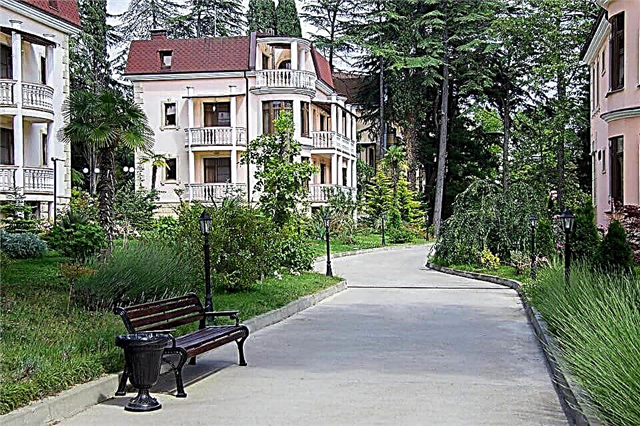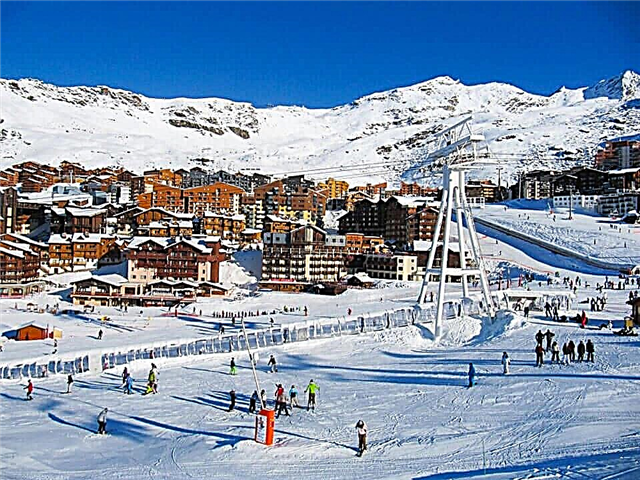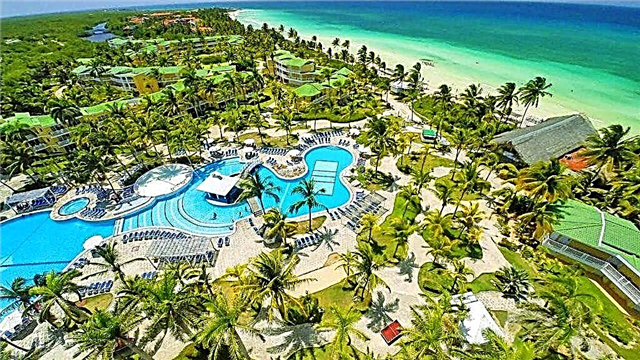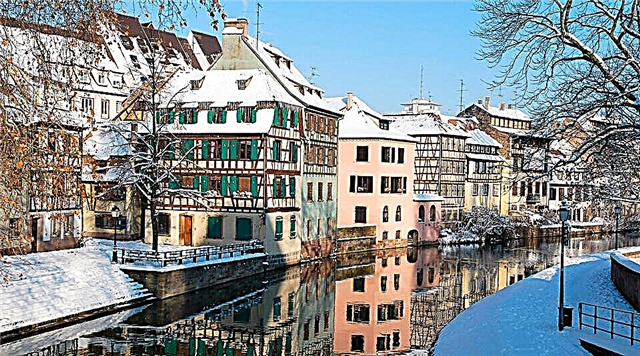Among the sights of Kazan there is an amazingly beautiful church - the Annunciation Cathedral in the Kazan Kremlin. Lovers of architecture come to see the example of traditional Pskov architecture, which is the most remote from Pskov. Pilgrims come to the old cathedral to venerate the reliquary with the relics of Archbishop Guria and pray in front of the icons of the 16th-17th centuries.
Temple history
The oldest Orthodox cathedral in Kazan was founded in October 1552 by order of the Russian Tsar Ivan IV the Terrible. In just three days, a wooden church appeared in a vacant lot near the destroyed khan's palace and mosques, and it was consecrated in honor of the Annunciation of the Most Holy Theotokos.

General view of the Annunciation Cathedral of the Kazan Kremlin
Three years later, Archbishop Gury (in the world - Grigory Grigorievich Rugotin) arrived in Kazan, who headed the new Kazan diocese. The number of Orthodox Christians in Kazan grew rapidly, so soon the small wooden church could hardly accommodate everyone who came to church services.

View of the northern facade of the Annunciation Cathedral of the Kazan Kremlin
In 1561 a brigade of bricklayers headed by architects arrived from Moscow to the city. St. Basil's Cathedral - Ivan Shiryay and Postnik Yakovlev. They took up the construction of walls, towers and a new stone cathedral in the Kazan Kremlin. White stone for construction was mined in a limestone quarry on the opposite bank of the Volga. The work went ahead quickly, so already in 1562 the first archbishop of Kazan, Guriy, consecrated a new church.
In the middle of the 16th century, the stone cathedral was half the size of the building that has survived to this day. Its domes were helmet-shaped. The church did not yet have side-chapels, and the walls ended with keeled zakomars, traditional for Pskov buildings.

Throughout history, the Annunciation Cathedral served as the spiritual center of the Volga region. All Russian sovereigns who visited Kazan prayed here, including Emperor Peter I and Empress Catherine II.
Alexander Sergeevich Pushkin entered the church when he came to Kazan to collect materials on the history of the Pugachev uprising. The Annunciation Cathedral was visited by the writer Alexander Nikolaevich Radishchev and the composer Sergei Vasilyevich Rachmaninov. In his youth, the best bass of Russia, Fyodor Ivanovich Chaliapin, sang in the temple choir.

Until 1918, the cathedral served as the cathedral church of the Kazan diocese, but with the change in the state system in Russia, its fate changed. During the civil war, White Czechs owned Kazan. V. I. Lenin ordered to knock the enemies out of the city at any cost. Parts of the Red Army besieged Kazan and began firing at the Kazan Kremlin with direct fire from cannons. The shells hit the cathedral and completely destroyed its domes.
When the Bolsheviks took possession of the old fortifications, they declared the Kremlin a military town and did not let the townspeople inside. All 7 churches were closed and organizations were evicted from their buildings. The Kazan Cathedral of the Mother of God monastery began to play the role of the cathedral of the diocese.

View of the eastern facade of the Annunciation Cathedral of the Kazan Kremlin
The believers managed to take out from the Annunciation Cathedral the shrine with the relics of St. Guria and several old icons. Church hierarchs insisted that valuable items from the cathedral sacristy should not be thrown out into the street, but transferred to the Provincial Museum. This is how gold embroidery, liturgical vessels, rare small plastic items, ancient manuscripts and early printed books were saved.
In 1928, there was an active campaign against religion in the country. In Kazan, the beautiful bell tower of the cathedral, the chapel of St. Guria, four chapters and a porch on the western side of the temple were destroyed. The five-tiered bell tower with a height of more than 50 m stood for almost 300 years, but was mercilessly dismantled into bricks. The same was done with many churches in Kazan and the environs of the city.

Annunciation Cathedral of the Kazan Kremlin from the side of the Syuyumbike tower
Only the main building with a central drum remained of the Annunciation Cathedral. Inside it were arranged four rows of wooden floors, which housed the state archive of the Tatar Republic. The watchmen lived in the former cell of Saint Gury, and vegetables were kept in the spacious cellars of the cathedral.
The temple stood in a disfigured form until the mid-1970s, but then it was restored. There was not much money, so the builders performed only the most urgent work.

Cathedral domes view
The major restoration of the architectural monument was carried out in 1995-2005, to the 450th anniversary of the Kazan diocese. Many experienced architects, historians and craftsmen took part in this restoration. Experts have opened and renewed old wall paintings, made a new iconostasis, chandeliers and wall icon cases. The old cathedral returned to its former beauty and took its rightful place among other monuments of the Kazan Kremlin.
Architectural features and interiors
For several centuries, the main church of the Kazan Kremlin has experienced many fires and reconstructions. Despite the changes, the cross-domed church is well preserved. The Pskov style of architecture is guessed in simple, harmonious proportions and in ornaments that adorn the apses and the base of the central chapter.

Since the 17th century, the cathedral has been crowned with four onion domes. These days they are blue and decorated with bright gold stars. In the middle there is a gilded dome, made in the tradition of the "Ukrainian Baroque".
After the last major restoration, inside the cathedral, you can see the frescoes, which were made by an artel of masters under the guidance of the famous icon painter of the 19th century L.N.Sofonov. The colorful murals cover several thousand square meters. The frescoes are dedicated to scenes from the Gospel, the history of Kazan and the local diocese.

View of the Monument to the Architect of the Kazan Kremlin against the background of the Annunciation Cathedral
A fresco depicting the Kazan Icon of the Mother of God dates back to the 17th century. It was discovered during the restoration of the temple in the 1990s. The oldest painting of the 16th century, the New Testament Trinity, is located in the old part of the cathedral, which was built by Pskov masters.
In the one-storey attached refectory, the floor of massive cast-iron slabs has been preserved. They were cast in 1743 at the Verkhneturinsky plant of the Demidovs.

From the Annunciation Cathedral less than 100 m to the famous Muslim mosque Kul-Sharif. Kazan is tolerant of different religions, and this is confirmed by the good neighborhood of temples of different religions. After the last restoration, the bells are inside the Orthodox cathedral, so their sound is heard only in the temple.
As a sign of respect for someone else's faith, the call to prayer of the muezzin - adhan is allowed to be broadcast only inside the mosque. So the Christian church and the Muslim temple do not interfere with each other on holidays and during divine services.
Old necropolis

The tradition of burial within the walls of Orthodox churches appeared in the XIV-XVII centuries. Necropolises were created for temple organizers and those parishioners who donated a lot to churches and monasteries during their lifetime. The most famous Russian temples-necropolises are Assumption Cathedrals in the Moscow Kremlin and Vladimir, as well as Peter and Paul Cathedral in St. Petersburg... Traditionally, bishops were buried in the main churches of the Orthodox dioceses of Russia. Burials were usually arranged under altars and inside churches.
The necropolis in the Annunciation Cathedral has existed for about 350 years. The first burial was made here in 1575, and the last grave appeared in 1910. To date, 17 burials of metropolitans and archbishops have been preserved in the cathedral - from Vassian to Nicanor. Burials with memorial plaques are located along the southern and northern walls of the main church, in the basement under the main altar and in the Borisoglebsk side-chapel.

Useful information for pilgrims and tourists
The Orthodox church is active.Children are baptized here and weddings are held. Church services are not held every day, but according to a special schedule. The morning liturgy begins at 8:30, a prayer service with akathist to St. Guriy at 15:00, and an all-night vigil at 16:00. You can enter the temple free of charge.
The Cathedral Museum is open from Tuesday to Thursday, Saturdays and Sundays from 10:00 to 18:00, and on Fridays from 11:00 to 20:00. A visit to the museum is paid. A ticket for an adult costs 100 rubles, and for seniors and students - 70 rubles. Admission is free for students. The ticket office stops working half an hour before closing.

How to get there
The oldest monument of the Kazan Kremlin is located in the historical center of the city, at the address - Sheinkman Passage, 2. The cathedral can be reached on foot from the Kremlevskaya metro station. It is convenient to get to the Kremlin entrance by buses No. 22, 28a, 83 and 89.
Attraction rating:











